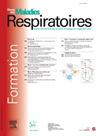Impaired lung epithelial-associated phagocytes recruitment during sepsis: A pivotal role of TLR2 signalling
IF 0.5
4区 医学
Q4 RESPIRATORY SYSTEM
引用次数: 0
Abstract
Introduction
Post-septic hosts exhibit altered lung immunity, leading to increased susceptibility to bacterial pneumonia. Epithelial cells can attract immune cells to the lung upon injury. Phagocytic cells are essential to epithelial wound healing by clearing debris, regulating inflammation, and promoting tissue repair. Our team showed that TLR2 acts as a susceptibility factor to secondary bacterial pneumonia in a murine model of polymicrobial peritonitis [1]. We also demonstrated that sepsis induces TLR2-dependent bronchial epithelial morphological and functional alterations including dysplasia [2]. Hence, we hypothesized that sepsis might induce dysfunction of the bronchial epithelium ability to recruit and activate phagocytic immune cells.
Methods
C57BL/6 J female mice were subjected to polymicrobial peritonitis induced by cecal ligation and puncture (CLP) or control sham surgery. Quantity and localisation of polynuclear neutrophils and macrophages were studied by immunohistochemistry at day 7 after surgery, prior to any secondary bacterial challenge.
Results
As compared to sham-operated mice, post-septic mice showed a significant decrease of whole lung and of epithelial-associated macrophages (median epithelial-associated macrophages staining ratio was 5.3% for septic mice compared to 2,2% for the controls, P = 0,048). No increase in epithelial-associated polynuclear neutrophils was observed despite a significant overall lung infiltration (median epithelial-associated neutrophils staining ratio 1,484% for septic mice compared to 0,7151% for the controls, P = 0,2571). Conversely, tlr2-/- post septic mice exhibited a significant increase of whole lung and epithelial-associated macrophages and polynuclear neutrophils in comparison with tlr2-/- control mice (median epithelial-associated macrophages staining ratio 6.726% for septic mice compared to 3,270% for the controls, P = 0,0159; median epithelial associated neutrophils staining ratio 6,530% for septic mice compared to 2,665% for the controls, P = 0.0159).
Conclusion
Our data show a TLR2-dependent defect in epithelial-recruitment of phagocytes post sepsis. These results suggest a crucial role of phagocytes in previously observed sepsis-induced alteration in epithelial morphology and functions (e.g. epithelial dysplasia) which may contribute to the increased susceptibility of post-septic hosts to secondary pneumonia. Further ex vivo experiments using primary air-liquid interface epithelial cultures from WT and tlr2-/- post-septic mice will allow us to identify the contribution of epithelial and immune TLR2 signalling in these alterations.
败血症期间肺上皮相关吞噬细胞募集受损:TLR2信号传导的关键作用
败血症后宿主表现出肺部免疫改变,导致对细菌性肺炎的易感性增加。上皮细胞可以在损伤时吸引免疫细胞到肺。吞噬细胞通过清除碎片、调节炎症和促进组织修复对上皮伤口愈合至关重要。我们的研究小组发现,TLR2在小鼠多微生物腹膜炎模型中作为继发性细菌性肺炎的易感因子。我们还证明败血症诱导tlr2依赖性支气管上皮形态学和功能改变,包括[2]发育不良。因此,我们假设脓毒症可能导致支气管上皮招募和激活吞噬免疫细胞的功能障碍。方法sc57bl / 6j雌性小鼠采用盲肠结扎穿刺(CLP)或对照假手术诱导多微生物性腹膜炎。术后第7天,在继发细菌攻击之前,通过免疫组织化学研究多核中性粒细胞和巨噬细胞的数量和定位。结果与假手术小鼠相比,脓毒症小鼠全肺和上皮相关巨噬细胞显著减少(脓毒症小鼠上皮相关巨噬细胞染色中位数为5.3%,对照组为2.2%,P = 0.048)。尽管肺整体明显浸润,但上皮相关的多核中性粒细胞未见增加(脓毒症小鼠上皮相关中性粒细胞中位数染色率为1,484%,而对照组为0,7151%,P = 0,2571)。相反,与tlr2-/-对照小鼠相比,tlr2-/-后小鼠的全肺、上皮相关巨噬细胞和多核中性粒细胞显著增加(脓毒症小鼠的上皮相关巨噬细胞中位数染色率为6.726%,而对照组为3,270%,P = 0,0159;脓毒症小鼠上皮相关中性粒细胞染色率中位数为6530%,对照组为2665%,P = 0.0159)。结论我们的数据显示败血症后吞噬细胞的上皮募集存在tlr2依赖性缺陷。这些结果表明,吞噬细胞在先前观察到的脓毒症诱导的上皮形态和功能改变(例如上皮发育不良)中起着至关重要的作用,这可能导致脓毒症后宿主对继发性肺炎的易感性增加。进一步的离体实验使用WT和tlr2-/-脓毒症后小鼠的气液界面上皮培养物将使我们能够确定上皮和免疫tlr2信号在这些改变中的作用。
本文章由计算机程序翻译,如有差异,请以英文原文为准。
求助全文
约1分钟内获得全文
求助全文
来源期刊

Revue des maladies respiratoires
医学-呼吸系统
CiteScore
1.10
自引率
16.70%
发文量
168
审稿时长
4-8 weeks
期刊介绍:
La Revue des Maladies Respiratoires est l''organe officiel d''expression scientifique de la Société de Pneumologie de Langue Française (SPLF). Il s''agit d''un média professionnel francophone, à vocation internationale et accessible ici.
La Revue des Maladies Respiratoires est un outil de formation professionnelle post-universitaire pour l''ensemble de la communauté pneumologique francophone. Elle publie sur son site différentes variétés d''articles scientifiques concernant la Pneumologie :
- Editoriaux,
- Articles originaux,
- Revues générales,
- Articles de synthèses,
- Recommandations d''experts et textes de consensus,
- Séries thématiques,
- Cas cliniques,
- Articles « images et diagnostics »,
- Fiches techniques,
- Lettres à la rédaction.
 求助内容:
求助内容: 应助结果提醒方式:
应助结果提醒方式:


